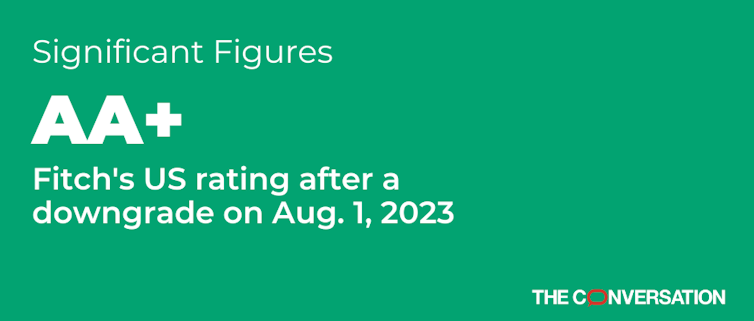US losing Fitch’s top AAA credit rating may portend future economic weakness

The formerly pristine reputation of the U.S. government’s debt lost a little more luster after another prominent rating agency demoted Uncle Sam from its AAA perch.
What does a downgrade of U.S. creditworthiness like this actually mean?
While the downgrade is unlikely to have much of an impact in the short term, its implications about the state and size of U.S. indebtedness will likely reverberate on Capitol Hill, where stalled negotiations over the budget could mark a step toward the Biden administration’s first government shutdown.
Fitch Ratings’ decision on Aug. 1, 2023, led to small declines in the stock and bond markets. But as an economist who studies the effects of monetary and fiscal policies, I’ve got longer-term concerns about the downgrade’s implications for U.S. economic growth.
To understand why, you have to look at both the reasons for Fitch’s downgrade and what it means for U.S. borrowing going forward.
Why Fitch downgraded the US
Just like people, the federal government has to balance the income it takes in and the money it spends for each fiscal year. Most federal income consists of tax revenue.
Since 2001, that revenue has rarely covered enough of the costs of everything the U.S. government pays for, from roadways to wars. When federal income falls short, the government fills the gap by borrowing money from investors.
That gap has gotten a lot bigger in recent years as the U.S. has spent trillions fighting COVID-19, contending with financial crises and funding several wars. As of Aug. 1, the U.S. Treasury owed US$32.6 trillion, both to bondholders and other parts of the federal government.
That’s part of the reason that Fitch cut the U.S. government’s long-term creditworthiness by one notch, from AAA – its highest rating – to AA+. Fitch also cited an “erosion of governance,” specifically pointing to recent efforts by conservatives to prevent the U.S. from raising its debt ceiling.
What happened last time
This was not the first time that a rating agency lowered the credit of the U.S. government.
In 2011, Standard & Poor’s, one of Fitch’s competitors, also downgraded its rating for the U.S. from AAA to AA+. S&P similarly blamed governance issues – that downgrade followed a similar debt ceiling standoff – as well as the burden of rising government debt.
At the time, Fitch issued a warning but it didn’t cut the U.S.’s credit rating until now.
The 2011 episode had no long-term effects on financial markets, including Treasury bonds – meaning investors remained happy to continue lending to the U.S. at favorable rates.
Does that mean Fitch’s downgrade will similarly have little long-term impact? Not necessarily.
Why things might be different
Any country seeking to borrow money in perpetuity needs lenders who are happy to lend.
For the U.S., that means it needs a constant supply of buyers for Treasury bonds and the other securities it sells. These securities are sold in auctions and then traded on global financial markets.
Investors of all kinds around the world find Treasurys attractive. They’re seen as safe, because the U.S. government is considered less likely to default than, say, a company going bankrupt.
Rating agencies like Fitch assess these risks and periodically adjust their credit rating scores based on their assessment on the ability of the federal government – and other borrowers – to keep up with their debt obligations.
“Repeated debt-limit political standoffs and last-minute resolutions have eroded confidence in fiscal management,” Fitch said in its announcement, in a reference to recurring fights among lawmakers over raising the debt ceiling.
 Rifts between Republicans and Democrats are making it harder for Congress to pass budgets and get other important work done. Delpixart/iStock via Getty Images Plus
Rifts between Republicans and Democrats are making it harder for Congress to pass budgets and get other important work done. Delpixart/iStock via Getty Images Plus
But if economists and financial analysts deem Treasurys to be growing riskier, then investors may become less interested in buying them. Alternatively, they may demand a higher interest rate in exchange for taking on the risk that the U.S. may default on its debts.
So, however the market reacts, I believe that this downgrade reflects the real deterioration of America’s fiscal standing as well as its ability to safeguard it.
And as economists and financial analysts decide Treasurys are becoming a riskier security to hold – whether because of the size of overall U.S. debt or because political brinkmanship is making a once-unthinkinkable default more likely – then investors may become less interested in buying them. Or, at least, they may demand the U.S. pay them more to take on the risk, resulting in higher borrowing costs for the government.
Ultimately, this means there will be less money for everything else the U.S. might want to spend money on – or the overall debt load will rise even faster.
Limited options
To cover its growing borrowing costs, the federal government has few options – none good.
It can borrow more money, which is seen as riskier – like taking out one loan to pay off another – and could result in an even lower credit rating and a continuous spiral of rising borrowing costs. Or it could hike tax rates or cut spending, both of which have political consequences and could be hard to accomplish given the degree of polarization in Congress.
Furthermore, research has shown that higher government debt is generally associated with lower long-term economic growth, which reinforces the problem by reducing revenue and thus requiring more debt.
So, while Fitch’s downgrade doesn’t signal an imminent financial crisis, it does serve as a warning as Congress engages in its fiscal fights – including the one over the budget that will heat up in September.







